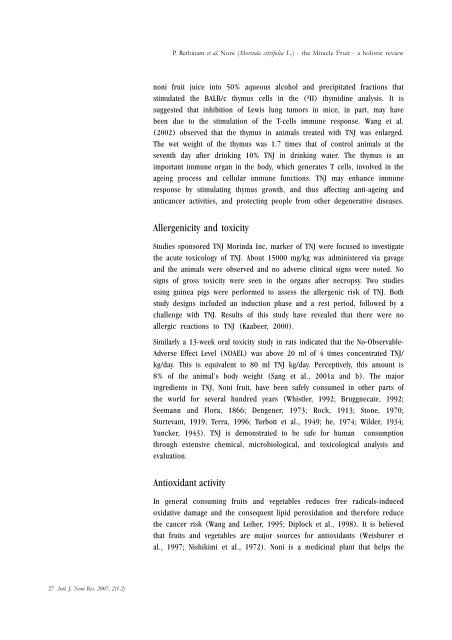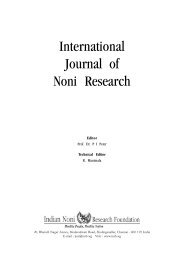International Journal of Noni Research - Noni Family
International Journal of Noni Research - Noni Family
International Journal of Noni Research - Noni Family
Create successful ePaper yourself
Turn your PDF publications into a flip-book with our unique Google optimized e-Paper software.
27 Intl. J. <strong>Noni</strong> Res. 2007, 2(1-2)<br />
P. Rethinam et al. <strong>Noni</strong> (Morinda citrifolia L.) - the Miracle Fruit - a holistic review<br />
noni fruit juice into 50% aqueous alcohol and precipitated fractions that<br />
stimulated the BALB/c thymus cells in the (³H) thymidine analysis. It is<br />
suggested that inhibition <strong>of</strong> Lewis lung tumors in mice, in part, may have<br />
been due to the stimulation <strong>of</strong> the T-cells immune response. Wang et al.<br />
(2002) observed that the thymus in animals treated with TNJ was enlarged.<br />
The wet weight <strong>of</strong> the thymus was 1.7 times that <strong>of</strong> control animals at the<br />
seventh day after drinking 10% TNJ in drinking water. The thymus is an<br />
important immune organ in the body, which generates T cells, involved in the<br />
ageing process and cellular immune functions. TNJ may enhance immune<br />
response by stimulating thymus growth, and thus affecting anti-ageing and<br />
anticancer activities, and protecting people from other degenerative diseases.<br />
Allergenicity and toxicity<br />
Studies sponsored TNJ Morinda Inc, marker <strong>of</strong> TNJ were focused to investigate<br />
the acute toxicology <strong>of</strong> TNJ. About 15000 mg/kg was administered via gavage<br />
and the animals were observed and no adverse clinical signs were noted. No<br />
signs <strong>of</strong> gross toxicity were seen in the organs after necropsy. Two studies<br />
using guinea pigs were performed to assess the allergenic risk <strong>of</strong> TNJ. Both<br />
study designs included an induction phase and a rest period, followed by a<br />
challenge with TNJ. Results <strong>of</strong> this study have revealed that there were no<br />
allergic reactions to TNJ (Kaabeer, 2000).<br />
Similarly a 13-week oral toxicity study in rats indicated that the No-Observable-<br />
Adverse Effect Level (NOAEL) was above 20 ml <strong>of</strong> 4 times concentrated TNJ/<br />
kg/day. This is equivalent to 80 ml TNJ kg/day. Perceptively, this amount is<br />
8% <strong>of</strong> the animal's body weight (Sang et al., 2001a and b). The major<br />
ingredients in TNJ, <strong>Noni</strong> fruit, have been safely consumed in other parts <strong>of</strong><br />
the world for several hundred years (Whistler, 1992; Bruggnecate, 1992;<br />
Seemann and Flora, 1866; Dengener, 1973; Rock, 1913; Stone, 1970;<br />
Sturtevant, 1919; Terra, 1996; Turbott et al., 1949; he, 1974; Wilder, 1934;<br />
Yuncker, 1943). TNJ is demonstrated to be safe for human consumption<br />
through extensive chemical, microbiological, and toxicological analysis and<br />
evaluation.<br />
Antioxidant activity<br />
In general consuming fruits and vegetables reduces free radicals-induced<br />
oxidative damage and the consequent lipid peroxidation and therefore reduce<br />
the cancer risk (Wang and Leiher, 1995; Diplock et al., 1998). It is believed<br />
that fruits and vegetables are major sources for antioxidants (Weisburer et<br />
al., 1997; Nishikimi et al., 1972). <strong>Noni</strong> is a medicinal plant that helps the








